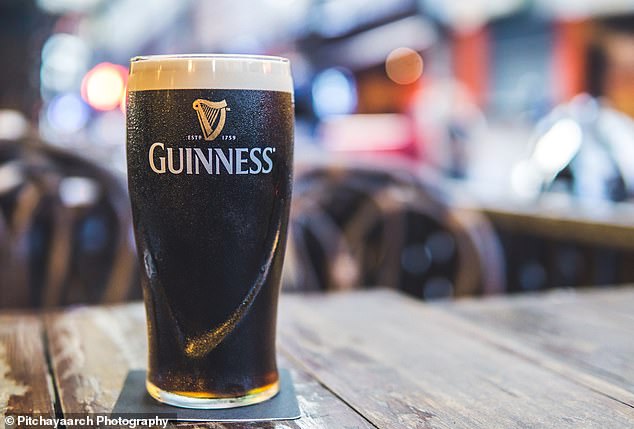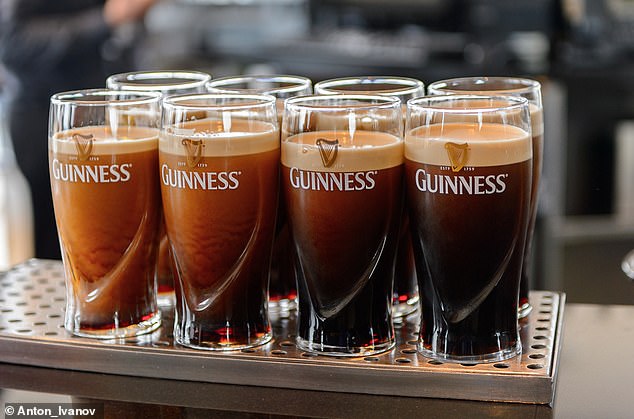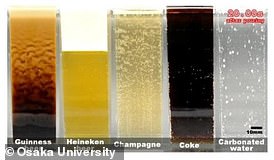How to pour the perfect pint of Guinness on St. Patrick’s Day, according to science
St. Patrick’s Day is here, which means large quantities of the world’s most popular stout are about to be consumed with wild abandon.
But despite its simple beauty, there is actually a very complicated physics behind Ireland’s most beloved beer: Dublin’s Guinness.
That’s why scientists have shared their secrets to the perfect pint of this ebony nectar, famous for its robust malty sweetness.
The iconic brew is packed with nitrogen gas and has long been considered unique because the bubbles flow downward.
Whether you pour it yourself at home or watch a bartender do it for you, here’s how to get the perfect pint of Guinness, according to science.
According to experts, the perfect pint of Guinness should be poured at a temperature of 45 degrees and served at a temperature of 6°C, with a head no thicker than 0.7 inches.
First of all, perfect Guinness should come in the classically shaped glass – which is wider at the top and slopes inwards closer to the bottom.
William Lee, professor of industrial mathematics at the University of Huddersfield, said this slanted shape is ideal for making Guinness bubbles flow downwards, allowing them to settle more quickly.
The shape directs bubbles downward near the wall of the container – even though there are bubbles rising in the center that we cannot see.
‘Near a sloping wall, the bubbles rise, leaving bubble-free beer, after which the bubble-free beer slides down the wall to the bottom of the glass,’ he told MailOnline.
When pouring, the clean, cold glass should be held at a tilted angle of 45 degrees – the optimal point for the beer to flow smoothly into the glass.
Guinness itself officially recommends the classic molded glass, not only because of its shape, but because the harp logo etched on the front helps with perfect pouring.
Experts told MailOnline that when pouring, the nozzle on the tap should be as close as possible to the harp on the glass, but without the two actually touching.
“As the beer begins to reach the golden harp on the glass, ensure that your bartender slowly begins to straighten the glass, again without dipping the mouthpiece,” a Guinness spokesperson said.

The perfect Guinness should be in the classic contoured Guinness glass (photo), which is wider at the top
Bubbles in a pint of Guinness flow down in a ‘cascade’
Guinness also recommends the famous ‘two-part pour’, which involves pouring two-thirds of the pint and letting the bubbles settle, before pouring the remaining third.
This ensures a creamy white foam head with a perfect thickness – 12 to 18 mm.
It is ideal to stop the first part of the pour at the top of the harp because if it is higher it will be too full, giving the pint too thick a head.
But stopping lower than the harp – which is at the widest part of the glass – will result in a head that is too thin after the final pour.
Guinness – which recommends a serving temperature of 6°C (42.8°F) – has been adding nitrogen gas to its kegs for more than half a century, resulting in smaller, more stable bubbles that don’t dissolve as easily.
This results in a light white head with mousse texture while tempering the burnt flavor of the roasted barley for the perfect balance.
Professor Philip Moriarty, an Irish physicist at the University of Nottingham, says this Guinness drink (which is poured from a barrel through taps) is likely to give it an edge.
While the can contains the famous ‘widget’: the small, white, nitrogen-filled ball from which the gas is released as soon as it is opened.
‘I think the debate about draft versus bottle or can certainly weighs heavily on the draft side,’ Professor Moriarty told MailOnline.
‘It’s the nitrogen in Guinness that sets it apart from other brands and the flow of nitrogen bubbles will be very different in draughts, especially compared to the rather more ‘explosive’ effect due to the nitrogen widget they put in cans.
“Again, whether that flow makes a difference in terms of overall flavor might be a matter of psychology rather than the physics of fluid flow.”

Pubgoers will be used to waiting ages for their beloved Guinness while the bar staff perform the ‘famous’ two-part pour. Pictured: Glasses of Guinness prior to the second part of the two-part pour
Many Guinness fans would probably agree that a glass of Guinness from a can or bottle is never as tasty as straight from the taps in the pub.
Guinness recognized this and last year released an ‘ultrasonic’ device called ‘Nitrosurge’, which only works with a special line of Guinness cans.
The £25 electronic device attaches to the top of the can and pours a perfectly straight stream of liquid – as if from a draught.
It means that the perfect Guinness can technically come from a can, as long as the Nitrosurge device is plugged in.

